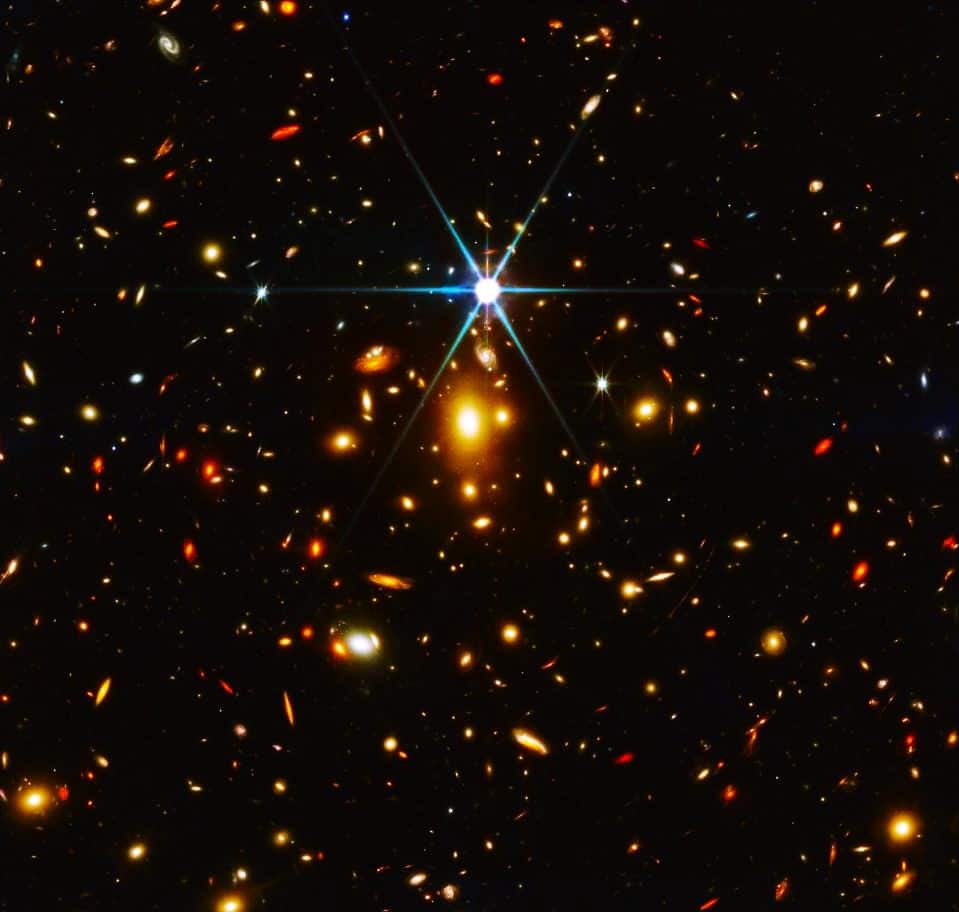On March 30, 2022, researchers at NASA revealed the oldest star ever detected: a massive star about 28 billion light-years away in the Sunrise Arc galaxy. Named Earendel, this distant star formed around 900 million years after the Big Bang. This also makes it the oldest star we have ever seen, and among the first stars ever formed in our universe.
A subsequent study by the James Webb Space Telescope in August of 2023 confirmed Hubble’s observations.
Originally discovered by the Hubble Space Telescope, the light from Earendel has been traveling for 12.9 billion years before reaching Earth, but the star itself is over 28 billion light-years away. This is because the expansion of the universe continually increases the distance between us and Earendel.
Because light takes time to travel the vast distances of the universe, the more distant an object is, the further back in time we are looking. Earendel is so old, and its light has been traveling for so long, it appears as it did when the universe was only 7 percent of its current age.
The discovery of Earendel is particularly important because, at such long distances entire galaxies only appear as smudges of light, and individual stars are indistinguishable from the billions of other stars in a galaxy.
How Did Researchers Find Earendel?

An image of the WHL0137-08 galaxy cluster captured by the James Webb Space Telescope. Earendel is visible here only as a tiny pixel in a thin smudge around the 5:00 position from the center of the imagel.
©”Earendel – the most remote star” by terryballard is licensed under CC BY 2.0. – Original / License
The Hubble Space Telescope first detected the star in the Cetus constellation area of our sky while observing a galaxy cluster named WHL0137-08. The gravity of the massive galaxy cluster is so strong that it warps and magnifies the light of any object behind it, acting like a galactic magnifying glass. Earendel lies within a galaxy known as the Sunrise Arc galaxy, which lies behind the WHL0137-08, so its light was magnified over billions of light-years, allowing the Hubble Space Telescope to see it.
The gravitational lensing of the WHL0137-08 galaxy cluster is so powerful it magnified the Sunrise Arc galaxy by a factor of 4,000. But the galaxy, and Earendel within it, still only appear as the tiniest of dots in the image, highlighting how truly distant they are. Without the gravitational lensing, the Sunrise Arc galaxy and Earendel would not be visible.
Using its Near-Infrared Camera (NIRCam), the James Webb Space Telescope imaged the star again in August of 2023, confirming that it is a star (and not something else). With this closer observation, researchers were able to classify Earendel as a B-type star (which means it is a bright, blue star), and likely has a smaller, red, companion star. The light from this smaller companion star was stretched and warped so much by the magnification of WHL0137-08 that it was undetectable by the Hubble Space Telescope, so only James Webb could see it.
Additional observation and study might reveal yet more distant objects. Scientists believe that the discovery of Earendel is just a stepping stone to other, earlier stars.
What Do We Know About Earendel?
Earendel’s official name is WHL0137-LS, and while it is an early star, it is not what is known as a “first-generation star”. These are the first stars formed in the universe, immediately after the Big Bang, and composed of only Hydrogen and Helium. Analysis by the James Webb Space Telescope has indicated that heavier elements might be present in Earendel.
Earendel is enormous. As it looks today, Earendel has a mass of between 50 to 100 solar masses and is over a million times more luminous, and two times hotter, than our own sun. Because it is so massive, Earendel likely died in a dazzling supernova shortly after it was born, and almost definitely doesn’t exist anymore.
Earendel is an Old English name meaning “morning star”, which is appropriate since it is among some of the first stars to appear in our galaxy. Scientists also chose this name because J. R. R. Tolkien created a character named Eärendil in his book, The Silmarillion. Eärendil voyaged through the skies with a bright jewel that was as bright as a star.
While the images have been stunning and interesting, research is still ongoing. NASA scientists are busy analyzing data from James Webb’s Near-Infrared Spectrograph (NIRSpec) to determine exact measurements of Earendel and the Sunrise arc galaxy. Soon, they will be able to determine the exact composition of Earendel and distance measurements for the galaxy as a whole.
The ability of James Webb to detect and study stars at this distance has confirmed the possibility to find even more distant objects. Peering into the distant past, almost to the doorstep of the Big Bang, will help scientists understand how our universe works and how it came to be the way it is today.
The photo featured at the top of this post is © "James Webb Space Telescope Artist Conception" by James Webb Space Telescope is licensed under CC BY 2.0. – License / Original
Thank you for reading! Have some feedback for us? Contact the AZ Animals editorial team.







